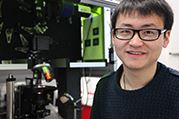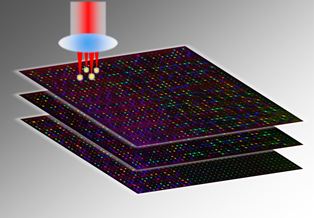Quartz glass stores data in 5D and could last over 1m years
10 July 2013
Scientists at the University of Southampton have, for the first time, demonstrated the recording and retrieval of data in quartz glass using several layers and dot sizes, and which has potentially unlimited lifetime.
The storage technology has unprecedented parameters on top of its longevity, including 360 TB/disc data capacity and thermal stability up to 1000°C. Anyone who has experienced failure of a USB memory stick after a few months or a hard drive after a few years would welcome even one human lifetime of storage.
The data is recorded on microscopic dots created in fused quartz. The five dimensions are size and orientation plus the three dimensional positions of the dots. A 300 kb digital copy of a text file was successfully recorded in 5D using an ultrafast pulse laser. The file is written in three layers of nanostructured dots separated by five micrometres (one millionth of a metre).
The self-assembled nanostructures change the way light travels through glass, modifying polarisation of light that can then be read by combination of optical microscope and a polariser.
 Head of the research, Dr Jingyu Zhang
(right) from the University of
Southampton's Optoelectronics Research Centre (ORC) said, “We are
developing a very stable and safe form of portable memory using
glass, which could be highly useful for organisations with big
archives. At the moment companies have to back up their archives
every five to ten years because hard-drive memory has a relatively
short lifespan. Museums who want to preserve information or places
like the national archives where they have huge numbers of
documents, would really benefit.”
Head of the research, Dr Jingyu Zhang
(right) from the University of
Southampton's Optoelectronics Research Centre (ORC) said, “We are
developing a very stable and safe form of portable memory using
glass, which could be highly useful for organisations with big
archives. At the moment companies have to back up their archives
every five to ten years because hard-drive memory has a relatively
short lifespan. Museums who want to preserve information or places
like the national archives where they have huge numbers of
documents, would really benefit.”

Drawing showing the 5D data storage
The technology could also make it feasible for people to store their complete genetic data for their medical record and help healthcare institutions overcome problems caused by the exponential rise in data storage requirements caused by rapid advances in genetic and imaging technologies.
Professor Peter Kazansky, the ORC’s group supervisor, adds: “It is thrilling to think that we have created the first document which will likely survive the human race. This technology can secure the last evidence of civilisation: all we’ve learnt will not be forgotten.”
This work was done under a joint project with Eindhoven University of Technology in the framework of EU project Femtoprint. The research was presented at the Conference on Lasers and Electro-Optics (CLEO’13) in San Jose earlier this year (5D Data Storage by Ultrafast Laser Nanostructuring in Glass in the CLEO's post deadline session).
The team are now looking for industry partners to commercialise this ground-breaking new technology.
Further information
EU project Femtoprint: /www.femtoprint.eu